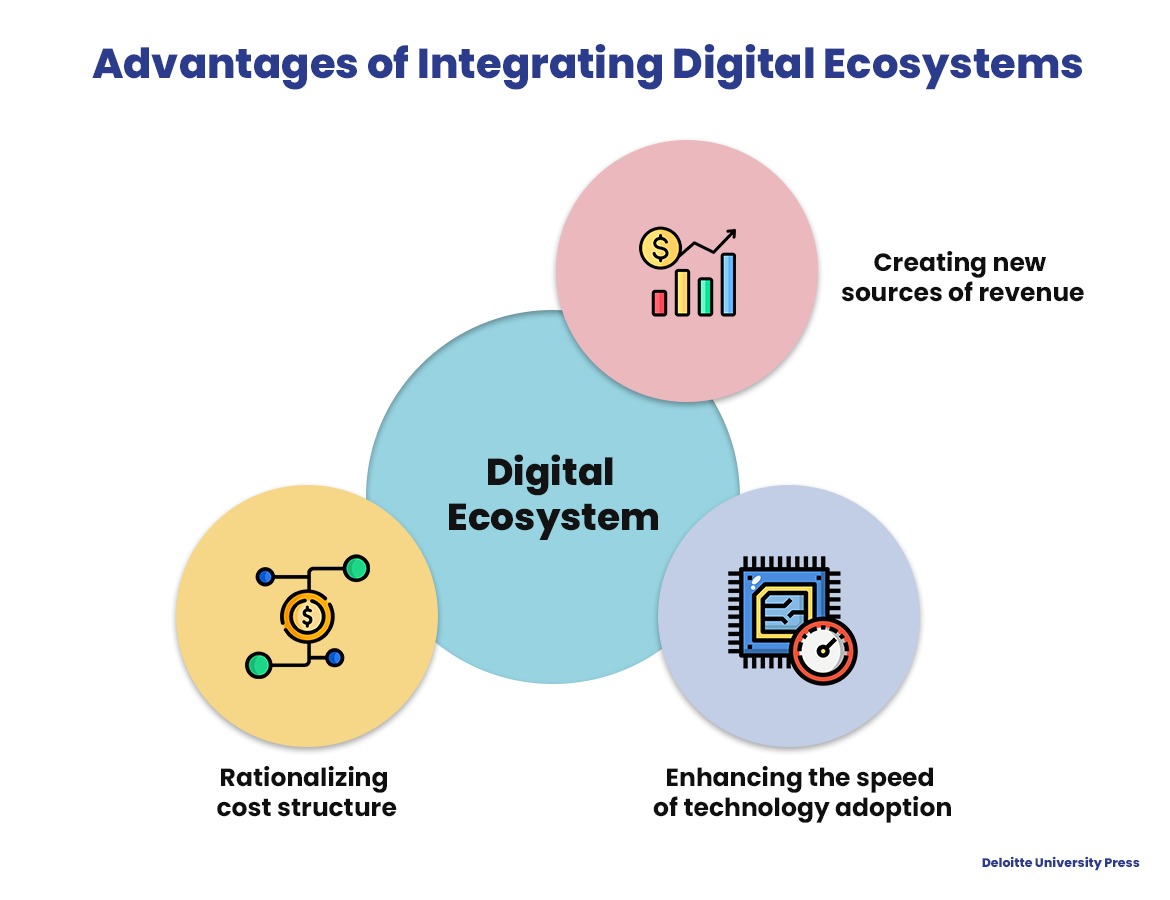
In today’s hyper-connected world, no technology platform can stand alone. Picture this, you open an app to book your flight tickets from New York to London. As you do that, you are prompted to take travel insurance, and then offered a list of hotels that you could consider staying at. This is an example of a digital ecosystem that was not possible a decade back. Digital ecosystems usually connect together technologies and services from different providers into one business interface to improve business outcomes and provide increased customer satisfaction.
Why businesses need digital ecosystems
Did you know that ecosystem-connected businesses grew faster in the last 5 quarters than in the preceding 5 years?
-Global Interconnection Index (GXI) 2023
Digital ecosystems exist everywhere. When businesses integrate third-party service providers into their systems, it allows them to leverage new technologies, as well as build automated processes around them. One of the biggest advantages of a connected ecosystem is that businesses can go to market quickly with new products by integrating supporting functionality already developed by other vendors.
The best part about a digital ecosystem is that it is constantly evolving and adapting to new technology infrastructure, business models, and user needs. If your business is looking to drive growth in the digital economy, this must figure high up in your innovation strategies in 2023.

It is true that some businesses have integrated third-party service providers such as CMS (customer management systems) etc. However, these are usually stand-alone systems with their data continuing to exist in silos.
There is a difference between good integration and an integration that is not scalable. Often businesses integrate new applications in an ad-hoc manner and their platforms are not technically equipped to take it on. If your systems within your ecosystem are having trouble communicating or require frequent manual updates, then your organization is not truly benefiting from your digital partnerships.
How different industries are creating value through digital ecosystems
Ecosystem building has become a red-hot topic since the pandemic amplified the benefits of an interconnected business model. For instance, auto insurance providers are integrating IoT available on mobile devices (Internet of Things) for new products such as usage-based insurance (UBI). Apple launched its AppleCard in partnership with Goldman Sachs to expand its ApplePay offering.
Companies need to decide on their value-creation agenda and this should guide their third-party partner selection and technology changes to support it. The priority could be growing the core business, creating new products and services, or improving operational efficiency. Whatever, the agenda be, the digital ecosystem requirements will be distinct for each industry sector. For instance, these 3 industries are chosen to highlight the diversity of each industry.
Digital ecosystems are the future of healthcare
Digital ecosystems in healthcare can improve the efficiency and effectiveness of care delivery by enabling the sharing of information between healthcare providers, patients, and other stakeholders. These systems usually integrate electronic health records (EHR) with lab and point-of-care systems but they can also go a level up by connecting to telemedicine platforms, medical devices, and healthcare innovators.
The challenge for existing healthcare platforms is that of digital infrastructure. They need their platforms upgraded to support open digital infrastructures so as to connect to diverse players in a secure environment.
Digital Ecosystems In Logistics
The logistics industry is in the middle of a massive shift to digital transformation. The supply chain trends bear this out. One of the big challenges that the logistics industry faces are poor coordination between warehouses and the various transporting networks, including inefficiency in vehicle usage. Digital transformation is picking up in these key areas – improved cargo delivery capabilities, more efficient last-mile delivery, supply chain execution and improved customer experience. Many of these processes are integrating increased automation.
Here are a few Gartner predictions:
By 2026, the logistics sector will have 75% of commercial supply chain management application vendors offering advanced analytics, AI, and data science capabilities embedded in their solutions.
By 2026, 25% of logistic companies will have replaced their aging platforms by switching to microservices-based application architecture that will support new technologies.
Impact of digital ecosystems on education
Similar to every other industry, the education sector is also undergoing a digital transformation. Today’s students are born in the digital age and demand quick access to academic materials and learning tools. This requires the integration of user-friendly applications that are already available in the market. Educational institutions need to develop digital ecosystems that provide robust connections between people, functions and experiences. Channel partner alliances can bring in “right-fit” technologies that build a strong support service.
Also read: What is the real cost of maintaining legacy systems?
Technology infrastructure to support digital ecosystems
Application programming interfaces (API) are the backbone of digital ecosystems. An API interface enables data to be shared across systems, allowing you to build new products and services that connect with existing ones.
To understand what an API interface does is to think of it as the universally accepted way for one application to “chat” with another. Each application can decide how it wants to “expose” itself to other applications that want to chat.
These well-defined interfaces allow applications built on different platforms using different programming languages to communicate with each other. While APIs reduce the amount of custom programming required, there is still some work involved in establishing the API interface and getting it to communicate using secured protocols.
This interoperability of APIs allows developers to integrate it with any internal or external modern technology. The challenge is with outdated software. Legacy systems often struggle to keep up with modern solutions, slowing down processes. This creates a bottleneck to integrating digital third-party solutions.
A word of caution, we do not recommend changing legacy systems in one go- it is too risky an approach. iTech has often approached well-entrenched legacy system modernization by building wrappers around the business logic. This addresses the problem of breaking monolith systems. New microservices can be built using the exposed business logic available in legacy systems. These microservices will incorporate the new business solutions that open up communication while shielding the legacy systems. This approach will ensure technology investments are made in a more equitable manner while gradually replacing the problem-ridden parts of the older software.







